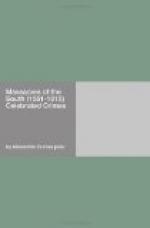At last, on the 31st of December, 1657, a final struggle took place, in which the Protestants were overcome, and were only saved from destruction because from the other side of the Channel, Cromwell exerted himself in their favour, writing with his own hand at the end of a despatch relative to the affairs of Austria, “I Learn that there have been popular disturbances in a town of Languedoc called Nimes, and I beg that order may be restored with as much mildness as possible, and without shedding of blood.” As, fortunately for the Protestants, Mazarin had need of Cromwell at that moment, torture was forbidden, and nothing allowed but annoyances of all kinds. These henceforward were not only innumerable, but went on without a pause: the Catholics, faithful to their system of constant encroachment, kept up an incessant persecution, in which they were soon encouraged by the numerous ordinances issued by Louis XIV. The grandson of Henri IV could not so far forget all ordinary respect as to destroy at once the Edict of Nantes, but he tore off clause after clause.
In 1630—that is, a year after the peace with Rohan had been signed in the preceding reign—Chalons-sur-Saone had resolved that no Protestant should be allowed to take any part in the manufactures of the town.
In 1643, six months after the accession of Louis XIV, the laundresses of Paris made a rule that the wives and daughters of Protestants were unworthy to be admitted to the freedom of their respectable guild.
In 1654, just one year after he had attained his majority, Louis XIV consented to the imposition of a tax on the town of Nimes of 4000 francs towards the support of the Catholic and the Protestant hospitals; and instead of allowing each party to contribute to the support of its own hospital, the money was raised in one sum, so that, of the money paid by the Protestants, who were twice as numerous as the Catholics, two-sixths went to their enemies. On August 9th of the same year a decree of the Council ordered that all the artisan consuls should be Catholics; on the 16th September another decree forbade Protestants to send deputations to the king; lastly, on the 20th of December, a further decree declared that all hospitals should be administered by Catholic consuls alone.
In 1662 Protestants were commanded to bury their dead either at dawn or after dusk, and a special clause of the decree fixed the number of persons who might attend a funeral at ten only.
In 1663 the Council of State issued decrees prohibiting the practice of their religion by the Reformers in one hundred and forty-two communes in the dioceses of Nimes, Uzes, and Mendes; and ordering the demolition of their meetinghouses.
In 1664 this regulation was extended to the meeting-houses of Alencon and Montauban, as Well as their small place of worship in Nimes. On the 17th July of the same year the Parliament of Rouen forbade the master-mercers to engage any more Protestant workmen or apprentices when the number already employed had reached the proportion of one Protestant, to fifteen Catholics; on the 24th of the same month the Council of State declared all certificates of mastership held by a Protestant invalid from whatever source derived; and in October reduced to two the number of Protestants who might be employed at the mint.




